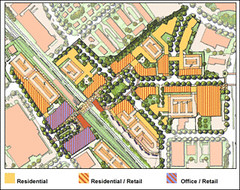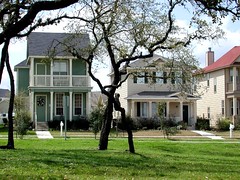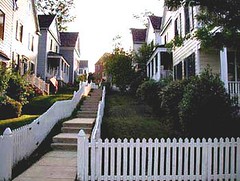Don’t stop thinking about tomorrow: moving smart growth forward

Posted February 1, 2010 at 1:39PM
What do we mean, exactly, when we describe or advocate “smart growth”? Is it the same as all those other phrases, such as “sustainable communities,” “urbanism,” “growth management,” “green development,” “livability,” or “location efficiency”? What is it that we want? What should we want? This is my 500th blog post on Switchboard - amazing, and a bit more about that at the end - so I am going to take the occasion to be briefly reflective about the state of our cause.
I certainly have convictions about how we should shape our communities, but my strongest belief is that we should never stop asking these questions of ourselves. None of us is so omniscient as to have the final answers, and in any event today’s right answer is not necessarily tomorrow’s. And I have a nagging feeling that we do not do enough examination and re-examination of our goals.
In the world of advocates, for example, we’re too busy advocating. There is a school of thought holding that at this point smart growth has been adequately defined and all we need is implementation in policy instruments. That’s not entirely true in my opinion. In the world of architecture and planning, there is lots of creative thought, but it cannot escape encumbrance by a financial interest in the outcome. Designers understandably tend to advocate the strategies for which their designs are most marketable.
So most of us, myself included, tend to be a bit tainted for one reason or another. But, since this is my blog, let me get straightaway to some thinking that I believe we need to do more of.
 First, smart growth advocates need to think beyond the transportation box that for now nearly totally dominates our thinking and resource allocation, especially at the national level. Yes, the emissions caused by sprawl threaten the planet and must be curtailed. I am proud of the leadership being shown by my NRDC colleagues and coalition partners on transportation reform, because we critically need new policy on the subject (and yours truly once devoted a significant chunk of my career to the effort). But we also need cleaner waterways, a more intact, productive and beautiful landscape, communities that provide opportunity for long-neglected populations, and a vision that unites rather than divides people.
First, smart growth advocates need to think beyond the transportation box that for now nearly totally dominates our thinking and resource allocation, especially at the national level. Yes, the emissions caused by sprawl threaten the planet and must be curtailed. I am proud of the leadership being shown by my NRDC colleagues and coalition partners on transportation reform, because we critically need new policy on the subject (and yours truly once devoted a significant chunk of my career to the effort). But we also need cleaner waterways, a more intact, productive and beautiful landscape, communities that provide opportunity for long-neglected populations, and a vision that unites rather than divides people.
Right now our natural constituencies feel threatened both by sprawl and by smart growth, and if we don’t wake up to that and work much, much harder to address it we have no chance of getting where we need to go. It is partly a matter of design, partly a matter of inclusive planning, and partly a matter of being more discerning in what we advocate and where. Right now there is almost no thinking in our world about nuances.
 In the world of design, unfortunately I do not get to choose what clients are willing to pay for. But, if I did, I would sponsor much, much more regional planning. (The policy companion would make it very easy to develop in accord with the plan, and very hard to do so inconsistent with the plan.) Without better regional visions, trying to make this or that suburban or exurban parcel better than it might otherwise be just doesn’t help that much. While it may be true that in ten or twenty years the parcel’s walkability and mix of uses may be able to capture a few trips internally that might otherwise go to long drives, very little will be done to stop the sprawl that grows up all around the oasis of good design, some of it because of the oasis; and even the good design will claim yet another piece of the once-rural landscape and generate its own share of long car trips and emissions. We’ve seen this happen more times than any of us can count. Think regionally.
In the world of design, unfortunately I do not get to choose what clients are willing to pay for. But, if I did, I would sponsor much, much more regional planning. (The policy companion would make it very easy to develop in accord with the plan, and very hard to do so inconsistent with the plan.) Without better regional visions, trying to make this or that suburban or exurban parcel better than it might otherwise be just doesn’t help that much. While it may be true that in ten or twenty years the parcel’s walkability and mix of uses may be able to capture a few trips internally that might otherwise go to long drives, very little will be done to stop the sprawl that grows up all around the oasis of good design, some of it because of the oasis; and even the good design will claim yet another piece of the once-rural landscape and generate its own share of long car trips and emissions. We’ve seen this happen more times than any of us can count. Think regionally.
In the world of green building, can we please pay more attention to where these buildings are going? (I fear that it will be very difficult as long as it is primarily the building industry that is writing green building standards.) A building with great green technology that contributes to sprawl is not green, so why do we keep allowing its proponents to claim that it is? And, while I’m at it, can we stop using rating systems to stamp the green label on everything under the sun until we get this right? I’m seeing green certifications for stadiums, parking lots, roads - will mountaintop mining be next?
 By the way, the opposite is also true: a “smart” development in the right place is not smart unless it also contains appropriate green features for such things as energy and water efficiency and resource conservation. And yet you will hardly ever see mention of that in a smart growth agenda. This is the twenty-first century, people. It’s about sustainability, not just density and transit.
By the way, the opposite is also true: a “smart” development in the right place is not smart unless it also contains appropriate green features for such things as energy and water efficiency and resource conservation. And yet you will hardly ever see mention of that in a smart growth agenda. This is the twenty-first century, people. It’s about sustainability, not just density and transit.
In the world of revitalization, we know we need to make it more inclusive and involve current community residents more actively in their neighborhoods’ futures. And I submit that we should also make it more green (literally) and beautiful. Part of this is so that new development can contribute to the restoration of urban ecosystems; but part of it also is to make our cities and neighborhoods more lovable, for people of all ages. Right now revitalization is the issue dearest to my heart, and that heart will be broken if we don’t do it in the very best way possible. In any particular neighborhood, generations will pass before we get another opportunity.
Now, I’ll grant that writing this mini-manifesto in a few paragraphs leaves a lot of filling in to do, and a lot of facing up to real-world considerations. I don’t know all the answers, but I do want us to explore them together, all of us in this business of smart urbanism, or whatever we call it.  That requires intellectual exploration, and more than a bit of humility. I sincerely hope our movement can make room for earnest, productive introspection as we continue to move forward, and I can promise you that this blog will. I cannot thank my readers enough for indulging me in this exercise and these hundreds of posts.
That requires intellectual exploration, and more than a bit of humility. I sincerely hope our movement can make room for earnest, productive introspection as we continue to move forward, and I can promise you that this blog will. I cannot thank my readers enough for indulging me in this exercise and these hundreds of posts.
Finally, since this is, after all, a milestone of sorts, I want to thank a few people for allowing me this platform to speak my mind. First mention has to go to Ian Wilker, the man most responsible for NRDC’s blogging site, who encouraged me from day one. Others include Phil Gutis, NRDC’s communications director, who has stood by me and supported me, even to a few skeptics; Scott, Kim and Will, who have made the site run and promoted it; and many NRDC and outside colleagues, far too many to name, who help me think. I expected to have fun doing this, but I did not anticipate how much professional opportunity and influence it would bring for NRDC and for me personally. Thanks, folks.
Tomorrow: some other bloggers who make me think.

